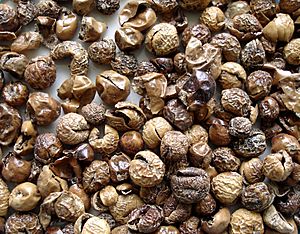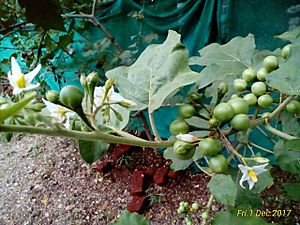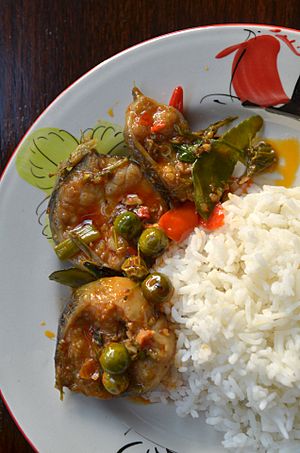Pendejera facts for kids
Quick facts for kids Pendejera |
|
|---|---|
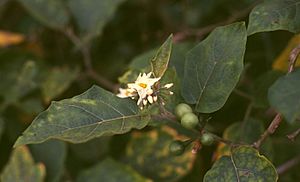 |
|
| Scientific classification | |
| Genus: |
Solanum
|
| Species: |
torvum
|
| Synonyms | |
|
Solanum ferrugineum Jacq. |
|
Turkey berry (also known as Solanum torvum) is a bushy plant that grows upright and often has spines. It's a perennial, meaning it lives for more than two years. People sometimes use its roots to help eggplant plants grow stronger and resist diseases. This helps eggplants produce fruit for a longer time.
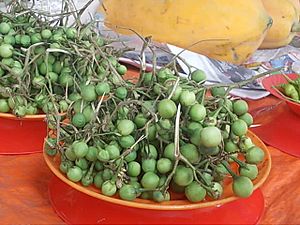
Contents
What Does Turkey Berry Look Like?
This plant usually grows about 2 to 3 meters (6 to 10 feet) tall. It can sometimes reach 5 meters (16 feet) high! It often has one main stem near the ground, but it can also have branches lower down. The stem's bark is gray and mostly smooth.
The twigs are gray-green and covered with tiny, star-shaped hairs. The plant has short, slightly curved spines. These spines can be found all over the plant, even on the middle part of the leaves. Sometimes, a plant might not have any spines at all.
The leaves are usually opposite each other or one per branch. They are wide and oval-shaped. Their edges can be smooth or deeply cut. The flowers are white and shaped like tubes with five pointed parts. They grow in clusters and fall off soon after they open.
The fruits are small berries that grow in bunches. They look like tiny green peas, about 1 centimeter (0.4 inches) across. When they are fully ripe, they turn yellow. These berries have thin flesh and many small, flat, round, brown seeds inside.
Where Does Turkey Berry Grow?
Turkey berry seems to be native to places like Florida and southern Alabama in the United States. It also grows across the West Indies, Mexico, Central America, and down to Brazil in South America.
It spreads very quickly in disturbed areas, like places where the land has been cleared. This makes it hard to know if some groups of plants are native or if they were brought there by people. Turkey berry has been introduced and now grows naturally in many tropical parts of Africa, Asia, Australia, and the Pacific Islands, including Hawaii.
In Jamaica, this berry is called "susumba" or "gully beans." People often cook it in a dish with saltfish and ackee. Some believe it has a lot of iron, and it's eaten when someone feels low on iron.
How Turkey Berry Lives and Grows
In places like Puerto Rico, turkey berry grows in higher areas that get a lot of rain. It also grows near rivers in drier spots. This plant can grow in all kinds of moist, fertile soil. It's found from sea level up to about 1,000 meters (3,300 feet) high in Puerto Rico, and even up to 2,000 meters (6,600 feet) in Papua New Guinea.
If turkey berry starts growing at the same time as other plants after a disturbance, it quickly grows taller than most grasses and other small shrubs. It grows best in full sunlight. It can also do well in light shade or shade for part of the day. However, it cannot survive under a thick forest canopy where there is little light. You can often see turkey berry plants or groups of them along roadsides, in empty lots, old pastures, recently abandoned farms, landslides, and river banks.
It is considered an invasive plant in New Caledonia. It was probably brought there around 1900.
Reproduction
Turkey berry plants start flowering and producing fruit continuously once they reach about 1 to 1.5 meters (3 to 5 feet) tall. The ripe fruits contain many seeds. On average, there are over a million seeds in one kilogram of dried fruits!
These seeds can sprout and grow into new plants. Young turkey berry plants are common in areas where the ground has recently been disturbed. Birds that eat fruit help spread the seeds by eating the berries and then dropping the seeds in new places. You can also grow new turkey berry plants from cuttings of branches.
Growth and Management
Turkey berry plants grow quickly, about 0.75 to 1.5 meters (2.5 to 5 feet) in height each year. However, they don't live very long; most plants only live for about two years.
If people want to remove the plant, they can dig it out of the ground. Just cutting the plant down will not kill it. Special plant-killing chemicals can be used on the leaves or on the cut stumps to get rid of them.
How People Use Turkey Berry
The fresh green fruits of the turkey berry are edible. They are used in Thai cuisine, for example, as an ingredient in certain Thai curries. They are also eaten raw with some Thai chili pastes. People also use them in Lao cuisine and Jamaican cuisine. In the Côte d'Ivoire, the fruits are added to soups and sauces.
In Tamil Nadu, India, people eat the fruit directly or cook it. In siddha medicine, which is a traditional Indian medical system, an extract from this berry is used to help with digestion.
Haitian Mythology
This fruit is reportedly used in some Haitian Vodou rituals.
Interesting Facts About Turkey Berry
Turkey berry contains various natural chemicals. Scientists are studying some of these chemicals to see if they could be useful for medicines. For example, one chemical called chlorogenin is found in the plant.
Some studies have looked at how extracts from turkey berry affect living things. It's important to know that consuming large amounts of turkey berry can sometimes cause problems. For instance, there have been reports of people feeling unwell after eating turkey berries prepared in certain Jamaican dishes.
Some traditional beliefs suggest that plant extracts might help with things like colds, coughs, pimples, and skin issues. Also, a chemical from the fruit called methyl caffeate has shown some promise in studies for helping with blood sugar levels in rats.
Hybrids
Scientists are trying to cross turkey berry with eggplant. They hope to transfer genes from turkey berry to eggplant that can help eggplants resist a plant disease called Verticillium wilt. This could make eggplants healthier and stronger.
Images for kids
See also
 In Spanish: Solanum torvum para niños
In Spanish: Solanum torvum para niños


